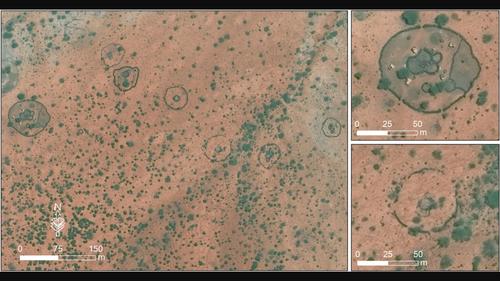当前位置:
X-MOL 学术
›
Remote Sens. Ecol. Conserv.
›
论文详情
Our official English website, www.x-mol.net, welcomes your
feedback! (Note: you will need to create a separate account there.)
A satellite perspective on the movement decisions of African elephants in relation to nomadic pastoralists
Remote Sensing in Ecology and Conservation ( IF 3.9 ) Pub Date : 2022-06-10 , DOI: 10.1002/rse2.285 Isla Duporge 1, 2 , Genevieve E. Finerty 2, 3 , Festus Ihwagi 4 , Stephen Lee 5 , Jane Wathika 2, 4 , Zijing Wu 6 , David W. Macdonald 2 , Tiejun Wang 6
Remote Sensing in Ecology and Conservation ( IF 3.9 ) Pub Date : 2022-06-10 , DOI: 10.1002/rse2.285 Isla Duporge 1, 2 , Genevieve E. Finerty 2, 3 , Festus Ihwagi 4 , Stephen Lee 5 , Jane Wathika 2, 4 , Zijing Wu 6 , David W. Macdonald 2 , Tiejun Wang 6
Affiliation

|
The African savannah ecosystem is populated by nomadic pastoralists who herd livestock in the day and corral them at night in temporary enclosures, called bomas, to protect them. The number and distribution of bomas on the savannah is important from an ecological perspective and may have a significant impact on wildlife movement. However, no study has yet examined this relationship. Here, using very high-resolution satellite imagery from two time periods, we quanitified changes in boma distribution and density across an area of 3377 km2 in the Laikipia-Samburu ecosystem of northern Kenya between 2011 and 2019. To assess wildlife movement in relation to bomas, we used a GPS data set on African bush elephant Loxodonta africana movement from 27 collared matriarchs representing herds of 9–15, covering 112 467 hourly GPS fixes over 31 months between 2018 and 2020. Our results showed a more than 46% increase in the total number of human-built structures between 2011 and 2019, the majority of which were bomas, representing a 21.9% increase in human-modified land area. Elephants readily adjusted their foraging habits and itineraries in this habitat shared with humans, who were also nomadic in space and time. Assessing the night–day activity ratio, we found elephants move more nocturnally when in closer proximity to bomas, particularly during the dry season. This temporal separation means elephants avoid the times humans are active in and around bomas while still accessing required resources—water and forage. The temporal shift was stronger during the dry season when shared resources are scarce. Using daily travel distance as a metric, we show elephants moved further in closer proximity to bomas which was likely linked to the need to travel between forage patches. Given the rise in human settlements, understanding the consequences of animals' behavioral adjustments is critical to understand the long-term population viability of elephant populations.
中文翻译:

非洲象与游牧民相关的移动决策的卫星视角
非洲大草原生态系统中居住着游牧民,他们白天放牧牲畜,晚上将它们关在称为 bomas 的临时围栏中以保护它们。从生态学的角度来看,大草原上 bomas 的数量和分布很重要,并且可能对野生动物的运动产生重大影响。但是,尚无研究检验这种关系。在这里,我们使用两个时间段的高分辨率卫星图像,量化了2011 年至 2019 年间肯尼亚北部 Laikipia-Samburu 生态系统 3377 平方公里区域内 boma 分布和密度的变化。评估与bomas,我们使用了非洲丛林象Loxodonta africana的 GPS 数据集代表 9-15 头牛群的 27 位带项圈女族长的运动,涵盖 2018 年至 2020 年 31 个月内的 112467 小时 GPS 定位。我们的结果显示,2011 年至 2019 年期间,人造结构的总数增加了 46% 以上,其中大部分是 bomas,代表人类改造的土地面积增加了 21.9%。在这个与人类共享的栖息地中,大象很容易调整它们的觅食习惯和行程,而人类在时空上也是游牧民族。评估夜间-白天活动比率,我们发现大象在靠近 bomas 时更喜欢夜间活动,尤其是在旱季。这种时间间隔意味着大象避开了人类在 bomas 及其周围活动的时间,同时仍能获取所需的资源——水和草料。在共享资源稀缺的旱季,时间转移更为强烈。我们使用每日行进距离作为衡量标准,显示大象移动得更靠近 bomas,这可能与需要在草料块之间行进有关。鉴于人类住区的增加,了解动物行为调整的后果对于了解大象种群的长期种群生存能力至关重要。
更新日期:2022-06-10
中文翻译:

非洲象与游牧民相关的移动决策的卫星视角
非洲大草原生态系统中居住着游牧民,他们白天放牧牲畜,晚上将它们关在称为 bomas 的临时围栏中以保护它们。从生态学的角度来看,大草原上 bomas 的数量和分布很重要,并且可能对野生动物的运动产生重大影响。但是,尚无研究检验这种关系。在这里,我们使用两个时间段的高分辨率卫星图像,量化了2011 年至 2019 年间肯尼亚北部 Laikipia-Samburu 生态系统 3377 平方公里区域内 boma 分布和密度的变化。评估与bomas,我们使用了非洲丛林象Loxodonta africana的 GPS 数据集代表 9-15 头牛群的 27 位带项圈女族长的运动,涵盖 2018 年至 2020 年 31 个月内的 112467 小时 GPS 定位。我们的结果显示,2011 年至 2019 年期间,人造结构的总数增加了 46% 以上,其中大部分是 bomas,代表人类改造的土地面积增加了 21.9%。在这个与人类共享的栖息地中,大象很容易调整它们的觅食习惯和行程,而人类在时空上也是游牧民族。评估夜间-白天活动比率,我们发现大象在靠近 bomas 时更喜欢夜间活动,尤其是在旱季。这种时间间隔意味着大象避开了人类在 bomas 及其周围活动的时间,同时仍能获取所需的资源——水和草料。在共享资源稀缺的旱季,时间转移更为强烈。我们使用每日行进距离作为衡量标准,显示大象移动得更靠近 bomas,这可能与需要在草料块之间行进有关。鉴于人类住区的增加,了解动物行为调整的后果对于了解大象种群的长期种群生存能力至关重要。











































 京公网安备 11010802027423号
京公网安备 11010802027423号